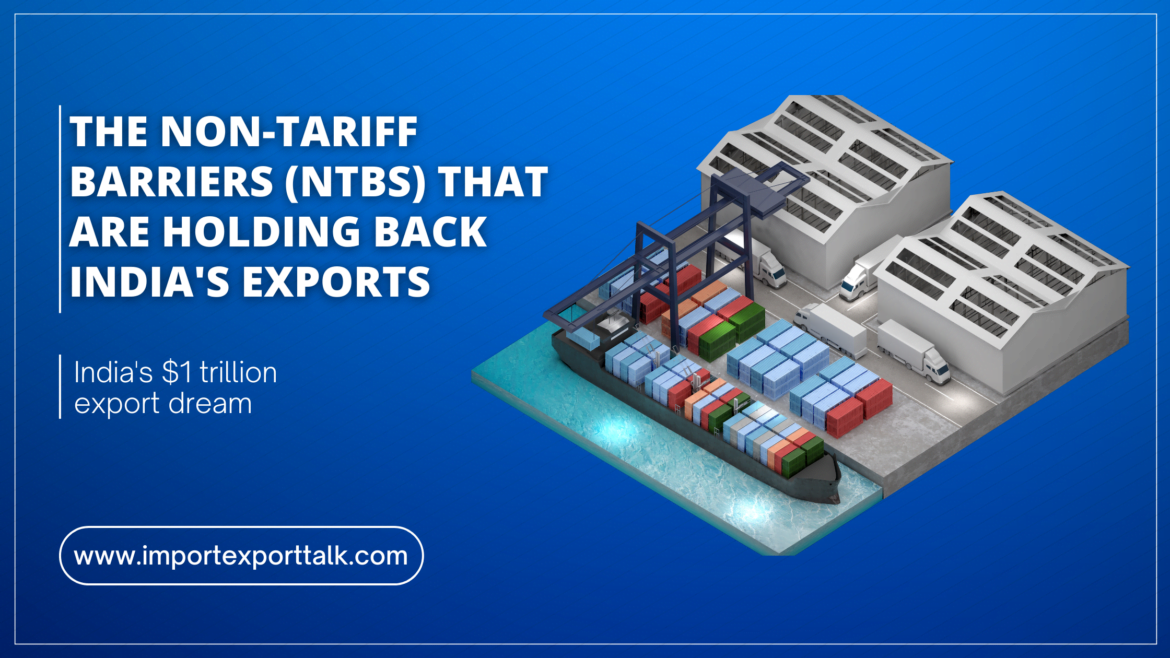India has set a target of exporting $1 trillion worth of merchandise goods by 2030. This is an ambitious goal, but it is achievable if India can address the challenges that are holding back its export growth.
Non-Tariff Barriers (NTBs):
One of the biggest challenges facing India’s exporters is non-tariff barriers (NTBs). NTBs are government measures that restrict trade, but do not involve tariffs. They can take many forms, such as quotas, technical barriers to trade, and sanitary and phytosanitary measures.
NTBs are a major problem for India’s exporters because they make it difficult and expensive to export goods to other countries. For example, a quota on steel imports can make it difficult for Indian steel exporters to sell their products in foreign markets. A technical barrier to trade, such as a requirement that all imported food products be certified as safe, can add to the cost of exporting food products from India.
A recent report by the Global Trade Review Institute (GTRI) found that NTBs are costing India billions of dollars in lost exports each year. The report estimated that NTBs reduced India’s exports by $20 billion in 2022.
“India must take each issue and address it in the shortest possible time,” Srivastava said adding “India’s exports are far below potential as they face NTBs in the EU (European Union), USA, China, Japan, Korea and many other countries”.
Key Indian exports that routinely face high barriers include — Chillies, Tea, Basmati Rice, Milk, Poultry, Bovine Meat, Fish, Chemicals Products to EU; Sesame Seed, Black Tiger Shrimps, Medicines, Apparels to Japan; Food, Meat, Fish, Dairy, Industrial Products to China; Shrimps to the US; and Bovine Meat to South Korea.
According to the report, the other products which face these barriers include Ceramic Tiles in Egypt; Chili in Mexico; Medicines in Argentina; Microbiological Regents in Saudi Arabia; Electrical, Medical Devices, Household Appliances in Brazil; Veterinary Pharmaceuticals, Feed Additives, Machinery in Russia.
The GTRI report also found that NTBs are disproportionately affecting India’s small and medium-sized enterprises (SMEs). SMEs are the backbone of India’s economy, and they are responsible for a large share of India’s exports. However, SMEs often lack the resources to navigate the complex web of NTBs that exist in foreign markets.
If India wants to achieve its $1 trillion export target, it needs to take action to reduce NTBs. This will require a coordinated effort by the government, businesses, and civil society. The government needs to make it a priority to negotiate the removal of NTBs in trade agreements with other countries. Businesses need to be more proactive in identifying and addressing NTBs. And civil society needs to raise awareness of the issue of NTBs and put pressure on the government to take action.
The GTRI report recommends that India take the following steps to reduce NTBs:
- Fast track negotiations to remove NTBs in trade agreements with other countries.
- Establish a dedicated NTB unit within the government to address NTBs.
- Provide financial and technical assistance to SMEs to help them comply with NTBs.
- Raise awareness of NTBs among businesses and civil society.
Export of milk and poultry, bovine meat products to the EU and bovine meat to China and South Korea is difficult due to the prevalence of foot and mouth disease (FMD) in India.
“India needs to invest in creating FMD free zones to export freely,” it suggested. It added that each consignment of Black Tiger Shrimp and Vannamei exported from India to Japan undergoes 100 per cent inspection by Japanese Authorities. This is done to rule out the presence of an antibiotic residue called Nitrofuran metabiolite AOZ. There has been no detection of AOZ in Black Tiger shrimp for the last three years.
Likewise, the EU has increased the sampling frequency from 10 per cent to 50 per cent on marine products exported from India due to frequent detection of prohibited antibiotics.
By taking these steps, India can create a more level playing field for its exporters and boost its export growth. This will help India achieve its $1 trillion export dream and create jobs and prosperity for its people.


2 comments
The Non-Tariff Barriers (NTBs) that are holding back India’s exports
barriers to trade. Certain nations apply non-tariff trade obstacles, such as technical trade barriers (TBTs) and sanitary and phytosanitary (SPS)